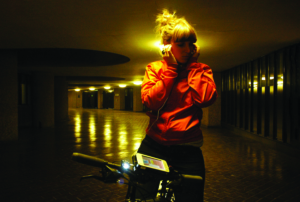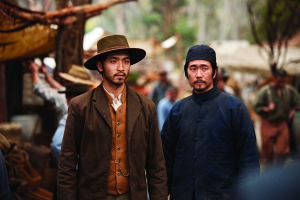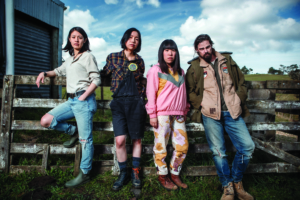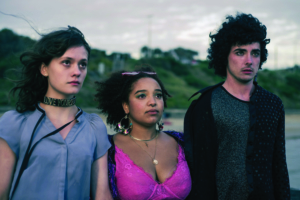The ABC’s high-concept genre series Glitch is a decidedly ‘Australian’ take on an international trend of shows about resurrection. First broadcast throughout July and August 2015, the show was created by industry mainstays Louise Fox and Tony Ayres, and centres on a small town in rural Australia where the dead are coming back to life. But Glitch is less horror series than a piece of magic realism, presenting itself as a realist Australian drama that has been invaded – or perhaps infected – by genre TV. Through this communion between social realism and genre, Glitch attempts to disturb the concept that there is a singular vision of ‘Australia’ – a notion that has been uncritically repeated in local, Eurocentric storytelling since the conception of Terra Australis Incognita.
Glitch follows police sergeant James Hayes (Patrick Brammall) as he tries to uncover the mystery of why formerly deceased locals are returning from the dead – including his wife, Kate Willis (Emma Booth), who died from breast cancer. The series begins with the introduction to its central mystery as six muddy, naked bodies emerge from their graves. Filmed in the fog of country night, the image is beautifully primal. It is telling that these strangers – stumbling around a cemetery, confused and nude – all react in human ways: with shyness, disgrace, pain, uncertainty. Glitch is not interested in playing with zombies; it is devoted to the fallout – social, personal and psychic – experienced by its core characters, as well as how they interact with one another and what it means to be given a second go at life.
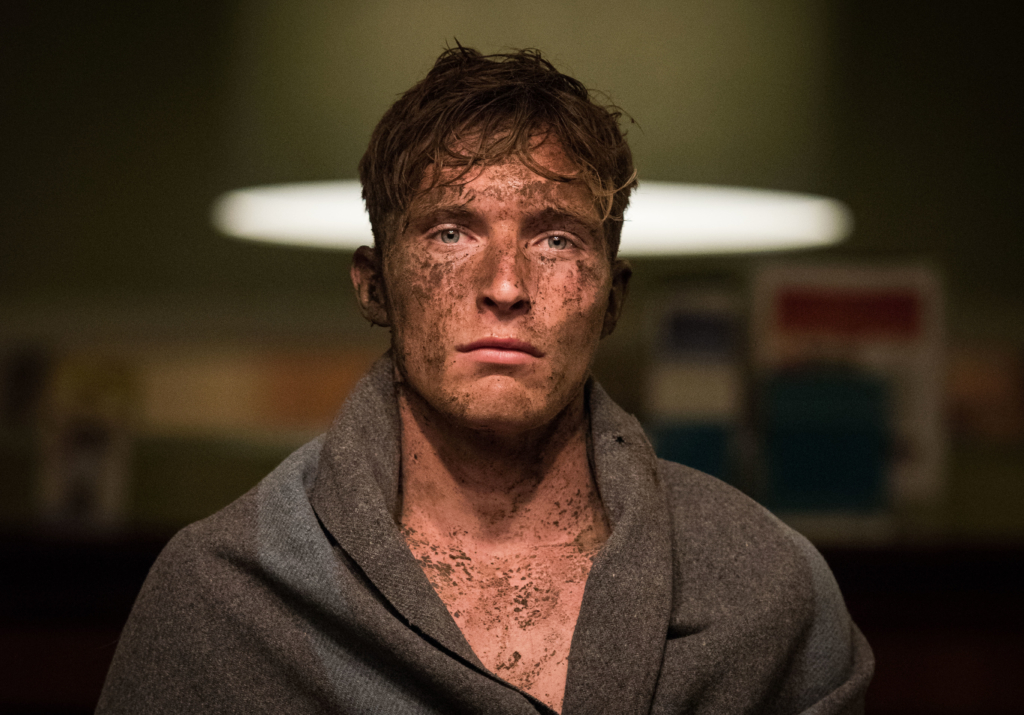
A television experiment
Glitch treads similar territory to recent international TV series – Resurrection, In the Flesh, French series Les Revenants and its American remake, The Returned – and Fox initially worried that the existence of these shows would negatively impact on the ABC production.[1]See David Knox, ‘Writer Worried The Returned Would Kill Off Glitch’, TV Tonight, 6 August 2015, <http://www.tvtonight.com.au/2015/08/writer-worried-the-returned-would-kill-off-glitch.html>, accessed 26 July 2017. Eventually, however, she viewed this apparent competition as a blessing rather than a curse: ‘The more those shows happened, in some ways the better it was for us because our points of difference are so clear.’[2]Louise Fox, quoted in ibid. Indeed, the directorial vision of TV veteran Emma Freeman – known for her work on Offspring, Puberty Blues and Tangle – is unfussy and naturalistic: Glitch looks more like these earlier quiet dramas than standard genre fare. As academic Janie Conway-Herron suggests, Freeman’s direction employs the ‘realist techniques’ of Australian series that rely on ‘the eye-witness account […] as if unmediated by the framing of a camera or a person behind that camera’.[3]Janie Conway-Herron, ‘A Glitch in the Script: Fantasy, Realism and the Australian Imagination’, Coolabah, no. 18, 2016, available at <http://revistes.ub.edu/index.php/coolabah/article/view/CO20161808/18773>, accessed 26 July 2017, p. 88. The series treats its dramatic material – both interpersonal relationships and the fantastical elements – as equally real, flattening the two until they become visually indistinguishable. According to Freeman,
The ‘glitches’ became a really integral device, and I developed a style that was very naturalistic to move gently between the present and the past, so it didn’t feel so much like a flashback but perhaps a glitch of the mind, a shifting of space and time.[4]Emma Freeman, quoted in Walter Marsh, ‘Glitch: Aunty Takes on Netflix, Australian Gothic and the “Resurrection” Genre’, Rip It Up, republished on Marsh’s website, 20 June 2016, <http://waltermarsh.com.au/post/145961719490/glitch-emma-freeman-interview>, accessed 26 July 2017.
The series treats its dramatic material – both interpersonal relationships and the fantastical elements – as equally real, flattening the two until they become visually indistinguishable.
Glitch was, in fact, an experiment for the ABC. In a first for the network, the entire series was made available on its iview streaming platform after the traditional broadcast of Episode 1. As such, Glitch was packaged as either a ‘binge’ show online or a week-to-week drama on broadcast television. Arguably, each viewing method highlighted different aspects of the show, or perhaps different aspects of what viewers might have wanted out of it: bingewatching privileged the ongoing plot and central mystery – what is happening and why – while the slower-paced week-to-week option aligned the show with prestige ABC dramas such as The Slap[5]The ABC has even marketed Glitch as a ‘must see drama event from the makers of The Slap’, highlighting the tie between the two series; see ABC, Glitch press kit, 2015, p. 1. that focus on characters and how they interact.
Australian reactions to the series following its release were mostly positive. The Sydney Morning Herald’s Melinda Houston contended, ‘The production team has made the most of the echo-y, slightly haunted vibe of small town Australia after dark to create a universe that’s both quotidian and otherworldly.’[6]Melinda Houston, ‘Melinda Houston’s TV Reviews: Glitch, Our Very Own Zombies’, The Sydney Morning Herald, 4 July 2015, <http://www.smh.com.au/entertainment/tv-guide/melinda-houstons-tv-reviews-glitch-our-very-own-zombies-20150624-ghwlpe.html>, accessed 26 July 2017. In The Guardian, Tom Ross gave the backhanded compliment that ‘[u]nusually for Australian television, the production quality trumps characterisation’.[7]Tom Ross, ‘Glitch: Australian Paranormal TV Series Struggles to Bring Its Undead to Life’, The Guardian, 31 July 2015, <https://www.theguardian.com/tv-and-radio/2015/jul/31/glitch-australian-paranormal-tv-series-struggles-to-bring-its-undead-to-life>, accessed 26 July 2017. The series went on to win an AACTA award for Best Television Drama Series and a Logie for Most Outstanding Drama Series, while Freeman won Best Direction in a TV Drama Series at the Australian Directors Guild Awards.
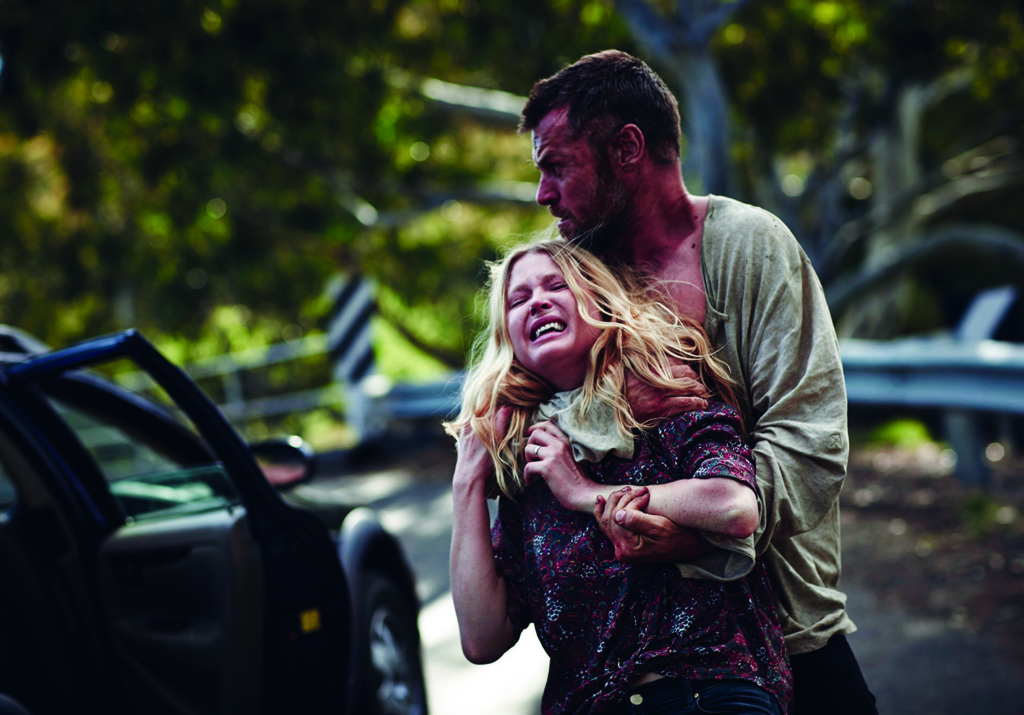
Upon its worldwide launch on Netflix in October 2016, international critics were similarly complimentary, all while tending to characterise the show as a ‘Netflix series’ – that is, as a single narrative unit that operates best when watched in bulk. ‘[Glitch is] almost cruel in its refusal to definitively address (much less resolve) its myriad concerns,’ wrote The Daily Beast’s Nick Schager. ‘In this era of drawn-out-to-the-point-of-emaciation streaming efforts […] it’s hard to complain about a tantalizing series that leaves one wanting more.’[8]Nick Schager, ‘Glitch: Netflix’s Addictive Supernatural Drama Could Be the Next Stranger Things’, The Daily Beast, 19 October 2016, <http://www.thedailybeast.com/glitch-netflixs-addictive-supernatural-drama-could-be-the-next-stranger-things>, accessed 26 July 2017. Elsewhere, Refinery29’s Hunter Harris compared Glitch to Netflix original series Stranger Things and recounted that viewers have described it as the streaming service’s ‘next big thing’.[9]Hunter Harris, ‘Stranger Things Fans Have Found Their Next Netflix Binge’, Refinery29, 20 October 2016, <http://www.refinery29.com/2016/10/126904/glitch-netflix-series-new-stranger-things>, accessed 26 July 2016.
Interestingly, international critics were also quick to identify some kind of innate ‘Australian’ aesthetic in the series. Decider’s Kayla Cobb noticed ‘a cool if vaguely unbelieving tone to the series that can only be described as Australian’, and aligned Glitch not with its resurrection-subgenre peers, but with Australian television comedies such as Wilfred and Please Like Me that ‘play with those same notes of exhausted acceptance’.[10]Kayla Cobb, ‘The Australian Supernatural Drama Glitch Should Be Your Next Netflix Binge’, Decider, 17 October 2016, <http://www.decider.com/2016/10/17/your-new-netflix-binge-glitch>, accessed 26 July 2017. Similarly, Schager noted that ‘the show conveys its off-the-beaten-path milieu’s sleepy atmosphere, and its dialogue is peppered with a number of Australian phrases […] that clearly mark it as an import’.[11]Schager, op. cit. Freeman herself was keenly aware of Glitch’s local bona fides during production, particularly its
embracing [of] our ‘Australian-ness’ and not being ashamed or trying to hide it, but also connecting to the truth, having a grounded-ness and naturalness to the environment as opposed to pushing it into a heightened area.[12]Freeman, quoted in Marsh, op. cit.
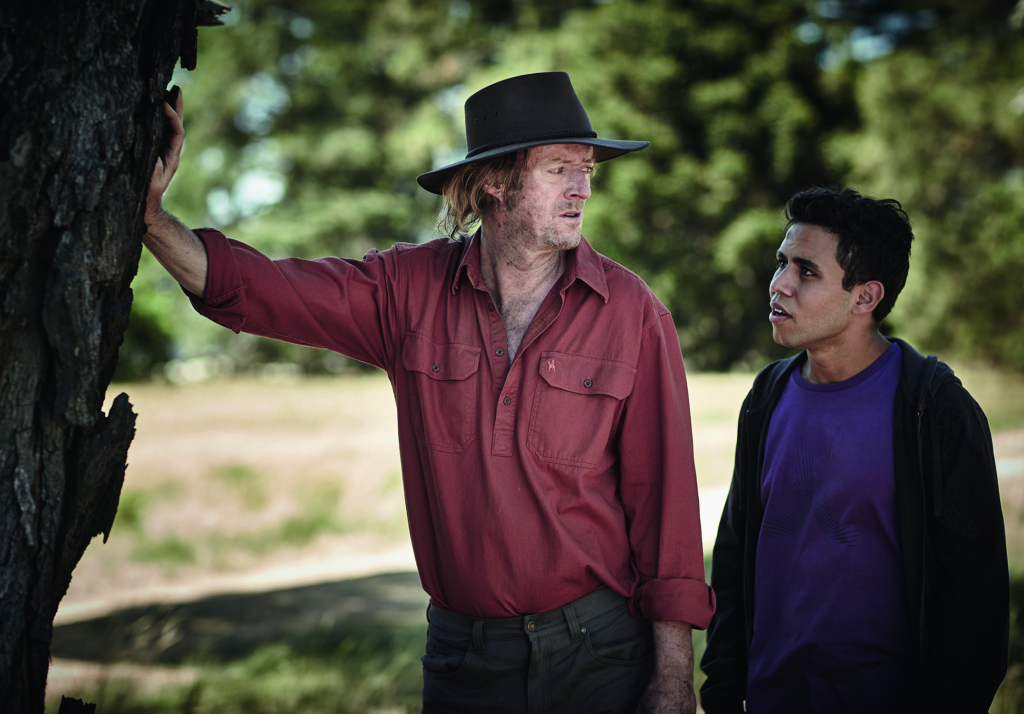
Reinvigorating archetypes
Glitch is set in the fictional town of Yoorana. In the first episode, we are introduced to the local pub; the supermarket; the cosy, two-man police station; and the wide, empty main street. Yoorana is a stand-in for Any Town, Australia, that is instantly recognisable – yet it’s never a caricature. Much like its setting, the series’ set of ‘risen’ characters form a constellation of post-colonial Australian archetypes: Paddy Fitzgerald (Ned Dennehy) is the settler; John Doe (Rodger Corser), the convict; Charlie Thompson (Sean Keenan), the digger; Maria Massola (Daniela Farinacci), the religious Italian migrant; and Kirstie Darrow (Hannah Monson), the ‘town slut’. Although these archetypal figures are, at first, painted in broad brush strokes, the show’s skilled ensemble cast breathe life into what might otherwise have been nothing more than stock figures.
The only resurrected character to fall outside any long-standing national archetype is Kate; not only is she the most contemporary of the risen, having died only two years prior, but she also has ties to many of the town’s ‘normal’ human characters – particularly James and her best friend Sarah (Emily Barclay). If anything, she typifies the protagonists of the Australian prestige dramas that Glitch’s realist dimensions seemingly hark back to. Kate is the ‘girl next door’, more at home in local productions such as Offspring or Love My Way. Her inclusion binds the show’s two halves together, bridging the social drama of Yoorana’s human characters and the mystery of the returned.
The risen’s first task in reclaiming their lives is remembering – or being told – their names. As the adage goes, to name something is to own something, and a focal point of the first season is this recollection of memory. Conway-Herron frames realism as ‘a narrative concept [that] involves a naming and recognition of objects, places, characters and ethereal emotions as if there is an externalized universal truth’;[13]Conway-Herron, op. cit., p. 88. she also identifies
a strong connection between postcolonial representations and Magic Realism in the way that they both draw attention to the blindness of the imperial centre to its own machinations. Australia as a nation […] is often blind to its treatment of its own Indigenous people while still looking towards a British imperial centre for a sense of identity.[14]ibid., p. 96.
For Conway-Herron – and, seemingly, for Glitch, too – realism is tightly aligned with a rationalistic Western worldview.

Despite having their own ongoing subplots, the primary role of Glitch’s human characters, in turn, is to help the risen remember their personal histories. In Season 1’s third episode, Maria’s retirement homebound husband, who now has dementia, has trouble recognising his still-young wife. Kirstie’s old boyfriend – wrongly convicted for her murder – appears in the fourth episode, in which the pair attempt to find some kind of closure. It’s significant that the only character who comes back to life but never recovers their real name – John Doe – feels the most vestigial. Throughout the series, he is a force of violence and uncertainty, but his quiet manner never lets the viewer in on his intentions or view of the world. He is told by the unreliable Dr Elishia McKeller (Genevieve O’Reilly) that he was a bushranger hanged for his crimes and buried in an unmarked grave, but the audience is given no definitive answers by the end of the first season.
One of Glitch’s most significant revelations happens when a closeted, obsessive publican helps Charlie remember his secret past. Charlie, who has now returned twice – once from the war, and this time from death – is forced to ponder the legacy of his old self: ‘How could Charlie be a hero if he didn’t die in the war?’ he asks. It’s a simple question, but, juxtaposed against the backdrop of the local RSL run by a military fanatic and the anonymous Anzac statue that stands outside, it’s affecting. When Charlie learns that he died a drunk back home, silently mourning the loss of the man he loved in the trenches, his belief in the Anzac myth is shattered. The identity that he regained with his name – a soldier who fought for his country, with all the bravery that such a life implies – no longer feels right. By ‘queering’ the digger, Glitch disturbs the notion that the mythology of ‘Australian’ identity is static.
But the series is not always so successful in its attempts to reframe such longstanding nationalistic ideas. Paddy – who, in his original life, was Yoorana’s first mayor – fits neatly into the mould of traditional Australian masculinity: beer-hungry, ready to brawl, a self-made man. His fortune was built on selling equipment and services to miners hoping to get lucky in the gold rush. When he breaks into the local pub in the first episode and pilfers something to wear off a clothes horse, it is telling that he pulls on a football jersey for the town’s local team. He may be a nineteenth-century colonist, but he looks like he could be the face of a Victoria Bitter advert. Yet Paddy’s statement during that episode that he is seeking ‘redress and restitution’ comes off as slightly hollow. While we later learn that he loved (and had a child with) a Koori woman, and that Beau (Aaron McGrath) – the Aboriginal teenager he has befriended – is actually his great-grandson, Paddy’s journey does feel like a straightening of the rug that white guilt sits on. Schager even describes the former mayor as ‘more of a mouthpiece for modern ideas than a coherently drawn character’.[15]Schager, op. cit.
Whether Glitch, like Paddy, truly seeks redress and restitution is worth interrogating – but, as Conway-Herron has argued, it is important ‘to recognise there are different ways of seeing the world’ and that ‘an Aboriginal Australian reality might be fantasy to an urban dwelling Australian framed by a European sensibility’.[16]Conway-Herron, op. cit., p. 92. While the series recognises, from time to time, these alternate ways of seeing reality, it never embraces them. It is notable that, throughout Glitch’s first season, the Aboriginal characters are almost always seen through white eyes, interacting with the show’s plot only through the will of Paddy and his mission to reclaim his estate. Indeed, that Beau’s family live alone at the very edges of Yoorana is not an accident. For a show about death and rebirth on Australian land, the first season exhibits a conspicuous lack of interest in First Nations people.
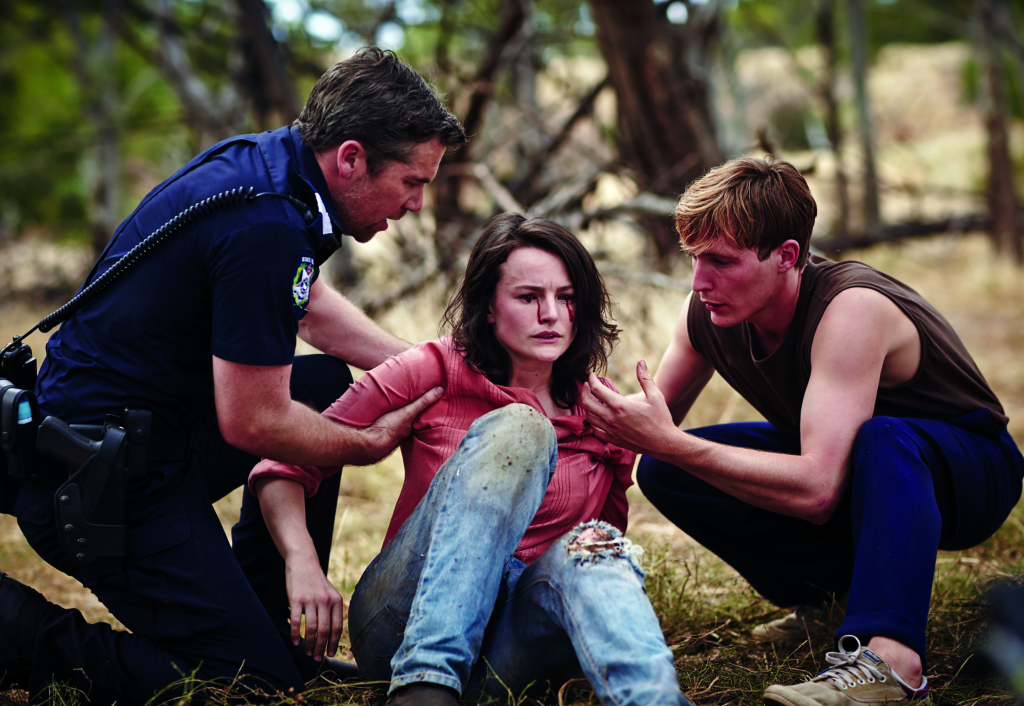
Moving on
The first season of Glitch ends without functional solutions to the show’s biggest mysteries – Why has any of this happened? Why can’t the risen leave Yoorana?[17]Carlo (James Monarski), the Italian-speaking prisoner of war held in Yoorana during World War II, dies (again) in the first episode after attempting to leave the town, and is all but forgotten soon after. He becomes a conduit for establishing the ‘rules’ of this storyworld: the living dead can’t go beyond the bounds of Yoorana. Who really is Dr McKeller? – but it delivers in spades when unveiling the characters’ emotional and personal riddles. Glitch melds together two strong televisual traditions, but the combination of its large cast and binge-programming ambitions does lead to a moreish but altogether-cramped series. Nevertheless, the national broadcaster’s gamble has paid off: international streaming giant Netflix has co-produced the show’s second season, the first two episodes of which premiered at this year’s Melbourne International Film Festival, with the entire season unveiled a month after. Glitch’s success was so assured, in fact, that the second season was announced before the first was even released worldwide.[18]Denise Petski, ‘Glitch Gets Second Season for Global Distribution on Netflix’, Deadline Hollywood, 14 October 2016, <http://deadline.com/2016/10/glitch-second-season-netflix-paranormal-drama-series-australia-1201836419>, accessed 26 July 2017. Through its inclusion in local film-festival programming and its continued relationship with Netflix, Glitch maintains this tightrope act between the realms of Australian prestige drama and accessible genre TV, between social and magic realism, and – by inference – between colonial and Aboriginal Australia.
http://www.abc.net.au/tv/programs/glitch/
https://clickv.ie/w/metro/glitch
Endnotes
| 1 | See David Knox, ‘Writer Worried The Returned Would Kill Off Glitch’, TV Tonight, 6 August 2015, <http://www.tvtonight.com.au/2015/08/writer-worried-the-returned-would-kill-off-glitch.html>, accessed 26 July 2017. |
|---|---|
| 2 | Louise Fox, quoted in ibid. |
| 3 | Janie Conway-Herron, ‘A Glitch in the Script: Fantasy, Realism and the Australian Imagination’, Coolabah, no. 18, 2016, available at <http://revistes.ub.edu/index.php/coolabah/article/view/CO20161808/18773>, accessed 26 July 2017, p. 88. |
| 4 | Emma Freeman, quoted in Walter Marsh, ‘Glitch: Aunty Takes on Netflix, Australian Gothic and the “Resurrection” Genre’, Rip It Up, republished on Marsh’s website, 20 June 2016, <http://waltermarsh.com.au/post/145961719490/glitch-emma-freeman-interview>, accessed 26 July 2017. |
| 5 | The ABC has even marketed Glitch as a ‘must see drama event from the makers of The Slap’, highlighting the tie between the two series; see ABC, Glitch press kit, 2015, p. 1. |
| 6 | Melinda Houston, ‘Melinda Houston’s TV Reviews: Glitch, Our Very Own Zombies’, The Sydney Morning Herald, 4 July 2015, <http://www.smh.com.au/entertainment/tv-guide/melinda-houstons-tv-reviews-glitch-our-very-own-zombies-20150624-ghwlpe.html>, accessed 26 July 2017. |
| 7 | Tom Ross, ‘Glitch: Australian Paranormal TV Series Struggles to Bring Its Undead to Life’, The Guardian, 31 July 2015, <https://www.theguardian.com/tv-and-radio/2015/jul/31/glitch-australian-paranormal-tv-series-struggles-to-bring-its-undead-to-life>, accessed 26 July 2017. |
| 8 | Nick Schager, ‘Glitch: Netflix’s Addictive Supernatural Drama Could Be the Next Stranger Things’, The Daily Beast, 19 October 2016, <http://www.thedailybeast.com/glitch-netflixs-addictive-supernatural-drama-could-be-the-next-stranger-things>, accessed 26 July 2017. |
| 9 | Hunter Harris, ‘Stranger Things Fans Have Found Their Next Netflix Binge’, Refinery29, 20 October 2016, <http://www.refinery29.com/2016/10/126904/glitch-netflix-series-new-stranger-things>, accessed 26 July 2016. |
| 10 | Kayla Cobb, ‘The Australian Supernatural Drama Glitch Should Be Your Next Netflix Binge’, Decider, 17 October 2016, <http://www.decider.com/2016/10/17/your-new-netflix-binge-glitch>, accessed 26 July 2017. |
| 11 | Schager, op. cit. |
| 12 | Freeman, quoted in Marsh, op. cit. |
| 13 | Conway-Herron, op. cit., p. 88. |
| 14 | ibid., p. 96. |
| 15 | Schager, op. cit. |
| 16 | Conway-Herron, op. cit., p. 92. |
| 17 | Carlo (James Monarski), the Italian-speaking prisoner of war held in Yoorana during World War II, dies (again) in the first episode after attempting to leave the town, and is all but forgotten soon after. He becomes a conduit for establishing the ‘rules’ of this storyworld: the living dead can’t go beyond the bounds of Yoorana. |
| 18 | Denise Petski, ‘Glitch Gets Second Season for Global Distribution on Netflix’, Deadline Hollywood, 14 October 2016, <http://deadline.com/2016/10/glitch-second-season-netflix-paranormal-drama-series-australia-1201836419>, accessed 26 July 2017. |


